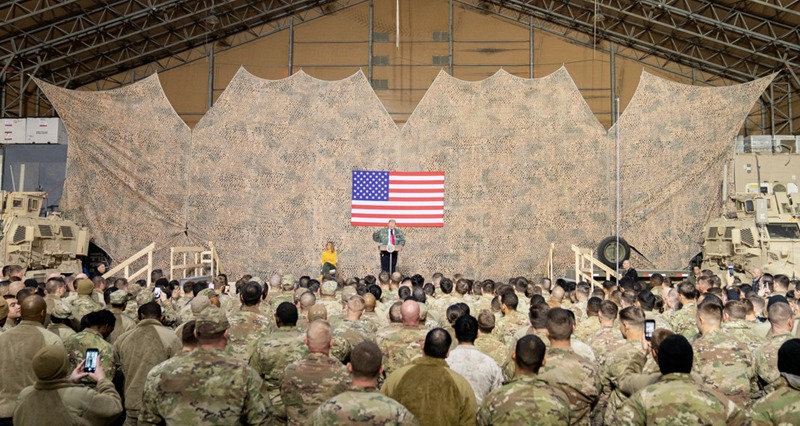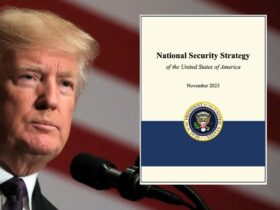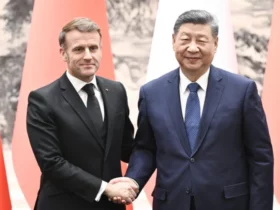According to President Donald Trump, the US has spent more than Seven Trillion Dollars in the Middle East for nothing.
If you look attentively at Trump’s latest visit to Iraq, it might become clear what he is talking about.
The American President visited US Soldiers in Iraq for just three hours before he had to flee from the country as fast as possible, despite that he was visiting an American military base in Al-Anbar/Iraq and was surrounded by American soldiers… soldiers, “who are there to fight and monitor the return of ISIS, and monitor Iran” as Trump claimed.
ISIS, “Created by Hillary Clinton and Obama”, as Trump said during his Presidential campaign.
TRUMP: Barack Obama is the founder of ISIS
Americans: pic.twitter.com/oUdNcU1wNj
— Rolly, My Friend (@ROLLYMYFRIEND) 27 de decembro de 2018
This is quite a difference compared to Iranian officials’ visit to Iraq during the Arbaeen rite (a 40 day commemorative period of mourning over the killing of Imam Hussein, the third Shia Imam, about 1400 years ago in Karbala/Iraq) just couple of months ago, where officials as high as Iranian deputy president Isaac Jahangiri were able to stroll freely in the streets of Iraq and walked from Najaf to Karbala. About 2.5 million Iranians also participated in this parade, while no American citizen will dare to walk in the streets of Baghdad. The United States of America Spent seven Trillion Dollars, but it was Iran who benefitted from the money.
While one of the US’ goals in invading Iraq was getting American soldiers close to the Iranian border, the Iranians were able to use the US’ mistakes to their benefit.
When Americans invaded Iraq in 2003, without any kind of plan for “Iraq after Saddam Hussein”, the Iranians were able to demonstrate that they had some ideas instead.
Americans believed that the Iraqi people were tired of Saddam Hussein and that they would be happy that the Americans invaded their country and overthrew the dictator, and that they somehow wouldn’t notice that they had to kill more than 200 thousand Iraqi citizens to do so, nonetheless in a tribal country where revenge is sacred.
Americans made the same mistake in 2001 when they invaded Afghanistan.
They thought that the Afghani people were tired of the Taliban’s rule and would thank their American saviors. They were wrong.
While Americans are still trying to initiate peace talks 18 years after invading Afghanistan, Admiral Ali Shamkhani, the secretary general of Iranian higher national security committee, is making an official visit to Kabul and claims that Iran has started peace talks with Taliban with the approval of the Afghan Government; some even believe that Iran was able to reach some agreements with Taliban to secure its eastern borders.
Americans thought that they were surrounding Iran and preparing for the final phase of their strategy: attacking Iran to implement the vision of Bernard Lewis and redraw the borders of the region.
Bernard Lewis was among the Orientalists who founded ideological justification for US domination of the Middle East.
Lewis, who was well connected to Israel, was able to convince the Bush administration that after the fall of the Ottoman Empire, the UK and France drew the borders of the Islamic countries according to their Interests and Spheres of influence in the Sykes-Pico agreement , and that US interests were not considered. After World War 2, he believed the US had earned the right to the biggest share of the cake.
Accordingly, the only way for the US to fulfill its interests in the region was to erase all these borders and draw them again as it saw fit.
Of course, the Lewis plan also considers Israel’s interests, and therefore, the region was to be redistributed into smaller ethnic countries which were all weak and forced to struggle between each other forever so that the Jewish country can live in peace.
All these countries, according to Bernard Lewis’ interpretation, should have to rely on the US for their existence.
What Americans didn’t consider was the will of the people of the region they invaded.
The Iranians, on the other hand, did invest in the people’s will. After the end of the Iran-Iraq war, one of the doctrines of Iranian policy was to find allies in neighboring countries and support them in coming to power.
The Iranians believe that military invasion of neighboring countries is impossible, but if allies come into power on their own, they can protect one another. They also decided to do whatever they could not to let someone like Saddam Hussein reach power in any neighboring country.
When the Taliban lost power in Afghanistan, Iranian allies were ready to reach power through elections, and then the same thing happened in Iraq.
Due to a critical lack of understanding of the region, American think tanks were not flexible enough to figure out what was happening.
They still don’t understand the ethnic differences between people in the Middle East and think that they can implement the same plans they implemented against Afghanistan and Iraq against other countries like Iran.
Any analyst will tell you that the reason Trump took such a huge risk in visiting Iraq, after two years being in power, was to face domestic pressure for his sudden decision to withdraw American soldiers from Syria.
Trump’s decision proved he understood that the US had lost in Syria and that Iran has become the main target to focus on.
In his short speech in Iraq, Trump mentioned both ISIS and Iran as the targets of American soldiers in the region.
With ISIS essentially gone, the US must either be planning to revitalize the terrorist organization or make a move against Iran.
One of the reasons the US has chosen Iraq as its new base is to keep its forces close to Iran and Syria for any future move.
Another reason could be that the US is planning to reshuffle the cards and create new chaos in the Middle East and they want to keep their soldiers in a safe place.
Whatever the reasons were behind Trump’s decision, we shouldn’t forget that the Iranians have been able to defeat American policies in the region for decades and that they are already getting prepared to deal with America’s next move.
If you consider that many Iranian high ranking diplomats and officials have studied in the US, it starts to become clear why Iranians can predict US politician’s moves while Americans are unable to understand Iranian politicians or the Iranian people in general, and thus repeat the same mistakes again and again.

















Leave a Reply